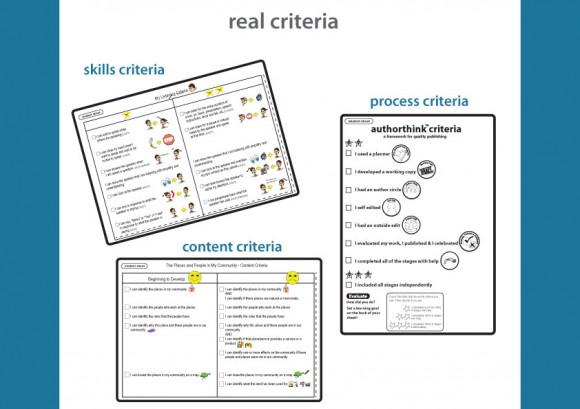
real criteria
Educators worldwide are recognizing the need to involve the learners in the assessment and evaluation process …
After all, it doesn’t really matter if the teacher and parent know a child’s specific strengths and weaknesses. If our learners are not aware of where they are, where they need to go and how they can get there … HOW WILL THEY GET THERE?
Criteria are commonly used with students in classrooms today. Unfortunately, all too often, the criteria have fallen short of achieving what they were designed to accomplish. Providing the learner with the opportunity to self-assess and evaluate using criteria is not enough. How often have we invited our learners to judge their work, only to ask afterwards, ‘Has this child evaluated the same piece of work that I have just looked at?’ Primary students will award themselves a smiley face or thumbs up for one of two reasons. First, because they want one! Second, they see their effort in a positive light if they worked hard. It matters little to them if that effort was directed in an entirely unfocused area, or if that effort did not address the required elements! This pattern is repeated at the secondary level.
Often, teachers provide a number scale as a guide: Content is worth 20, presentation 10, grammar, spelling and punctuation 10, etc. Although at first this approach may seem more specific, could we as teachers justify the difference between an 8 and an 8.5? A child may know that the top mark for presentation is 10, but does that knowledge alone enable the learner to achieve at that level?
We talk of the need for consistent judgments. That need is justified, but the approach we take in an effort to meet this challenge is not. Moderation is the universally accepted means of safeguarding against inconsistent judgments. Unfortunately, those condoning this practice have neglected to recognize that moderation deals only with the symptom of a much more fundamental problem… subjective and therefore ineffective criteria.
The first step toward developing criteria that are truly empowering for kids is recognizing the inherent failings in the hundreds of criteria ‘exemplars’ available to teachers on the internet and through various publications. Nonetheless, identifying those failings is simple – the challenge is to address them.

Reply